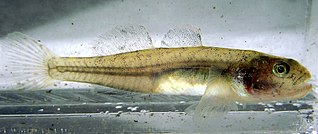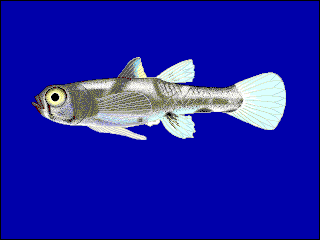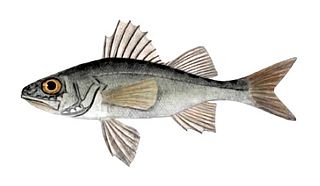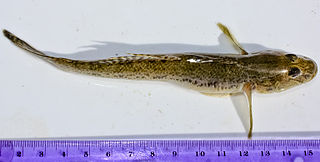
The quillback, also known as the quillback carpsucker, is a type of freshwater fish of the sucker family widely distributed throughout North America. It is deeper-bodied than most suckers, leading to a carplike appearance. It can be distinguished from carp by the lack of barbels around the mouth. The quillback is long-lived, with age beyond 50 years documented.

The slimy sculpin is a freshwater species of fish belonging to the family Cottidae, which is the largest sculpin family. They usually inhabit cold rocky streams or lakes across North America, ranging from the Great Lakes, southeast Minnesota, northeast Iowa, southwest Wisconsin and northeast Canada. Slimy sculpins have also been found roaming the cold streams of eastern Siberia. They are commonly confused with their closely related relatives, Mottled sculpin, and with tubenose gobies who are both freshwater fishes as well. The slimy sculpin is a nocturnal fish that usually spends most of its time on the stream bottom and seeks shelter under rocks and logs, especially during spawning season. When it swims, it sometimes appears to be "hopping" along the bottom because of its inefficient ability to swim. This is partly due to the absence of a swim bladder, which normally gives buoyancy to a fish.

Eucyclogobius newberryi, the Northern tidewater goby, is a species of goby native to lagoons of streams, marshes, and creeks along the coast of California, United States. The Northern tidewater goby is one of six native goby species to California.

The golden redhorse, Moxostoma erythrurum, is a species of freshwater fish endemic to Ontario and Manitoba in Canada and the Midwestern, southern, and eastern United States. It lives in calm, often silty or sandy waters in streams, small to large rivers, and lakes.

The sand goby, also known as a polewig or pollybait, is a species of ray-finned fish native to marine and brackish waters European waters from the Baltic Sea through the Mediterranean Sea and into the Black Sea where it occurs in sandy or muddy areas of inshore waters at depths of from 4 to 200 metres. This species can reach a length of 11 centimetres (4.3 in) TL. This species is sometimes kept in public aquariums. The sand goby is of a sandy colour, with darker markings on the sides and a creamy-white underside. In the breeding season the male fish has blue spot at the rear of the first dorsal fin, ringed with white. The fish has a slender body, and the head is about a quarter of the total length.

The black goby is a species of ray-finned fish found in the Eastern Atlantic and Mediterranean Sea and Black Sea. It inhabits estuaries, lagoons, and inshore water over seagrass and algae. It feeds on a variety of invertebrates and sometimes small fish. This species can also be found in the aquarium trade.

The dwarf pygmy goby or Philippine goby is a tropical species of fish in the subfamily Gobionellinae from brackish water and mangrove areas in Southeast Asia. It is one of the smallest fish species in the world. Males reach maturity at a standard length of 0.9 cm (0.35 in) and can reach up to 1.1 cm (0.43 in) in standard length, while the females can grow up to 1.5 centimetres (0.59 in) in total length. Adults weigh around 4 milligrams (0.00015 oz). It is known as bia and tabios in the Philippines.

Butis butis, the crazy fish, duckbill sleeper, or upside-down sleeper, is a species of sleeper goby that are native to brackish and freshwater coastal habitats of the Indian Ocean and the western Pacific Ocean from the African coast to the islands of Fiji. They prefer well-vegetated waters and can frequently be found in mangrove swamps. They are small, drably-colored fish, reaching a maximum length of only 15 cm (5.9 in). They are predatory and are known for their behavior of swimming vertically – or even upside down – while hunting.

The sleepy goby is a species of fish in the family Gobiidae.

Common percarina is a species of fish in the family Percidae. It is found in northwestern Black Sea basin in estuaries and coastal lakes, and in the lower reaches of rthe rivers that drain into that part of the Black Sea. It is a carnivorous species.

The channel darter is a species of freshwater ray-finned fish, a darter from the subfamily Etheostomatinae, part of the family Percidae, which also contains the perches, ruffes and pikeperches. It is native to North America where it typically occurs in the sandy or gravelly shallows of lakes and in small and medium-sized rivers in riffles over sand, gravel or rock bottoms. It is a small fish ranging from 34 to 72 mm in length, olive brown with darker speckles and sometimes with a dark spot below the eye and dark blotches along the flank. It feeds mostly on insect larvae and other small invertebrates and breeds in small streams. This species is listed as threatened by the Canadian Species at Risk Act (SARA) but overall it has a wide range and numerous sub-populations and the International Union for Conservation of Nature has rated it as a "least concern species".

The two-spotted goby is a species of goby native to marine and brackish waters of the eastern Atlantic Ocean where it can be found from the Faeroes and Norway to the northwestern coast of Spain. It has also been recorded from Estonia though records from the Mediterranean Sea are uncertain. They are common on all coasts of the United Kingdom. This species can reach a length of 6 centimetres (2.4 in) TL.

Glossogobius giuris, the tank goby, is a species of goby native to fresh, marine and brackish waters from the Red Sea and East Africa through South Asia and the Indian Ocean to China, Australia and the islands of the Pacific Ocean. This species can also be found in the aquarium trade. It is also known as the bar-eyed goby, flat-headed goby and the Gangetic tank goby.

The Cambodian logsucker, also known as stonelapping minnow or false Siamese algae eater, is a species of ray-finned fish in the genus Garra. It is found in Southeast Asia.

The Java barb, more commonly known as silver barb in aquaculture, is a species of ray-finned fish in the genus Barbonymus.

The western tubenose goby is a species of goby native to fresh waters of the Black Sea and Aegean Sea basins,. It has recently spread as an invasive species to Central and Western Europe and to North America. Previously Proterorhinus semilunaris was considered as a junior synonym of Proterorhinus marmoratus, but was confirmed as a distinct species based on molecular analysis.
Pseudogobiopsis is a genus of fish in the goby family, Gobiidae. They are native to fresh and brackish waters of southern and southeastern Asia. The genus is mainly distinguished by the number and arrangement of fin rays and spines, headpores, and sensory papillae, the large mouths of the males, a fleshy or bony flange on the pectoral girdle, and the shape of the genital papilla.

The bigmouth shiner, is one of the 324 fish species found in Tennessee. It is a common minnow species found in the midwest region, but found as far as the east coast. There has been little information researched about this unremarkable minnow outside of the general body plan and habitat. They are often found along with common shiner in streams.

Acanthogobius flavimanus is a species of fish in the goby family known by the common name yellowfin goby. Other common names include mahaze, Japanese river goby, Oriental goby, and spotted goby. It is native to Asia, where its range includes China, Japan, Korea, parts of Russia, Vietnam, and Malaysia. It has spread beyond its native range to become an introduced, and often invasive, species. It has been recorded in Australia, Mexico, and Florida and California in the United States.
The bigmouth chub is a species of fish native to West Virginia.


















